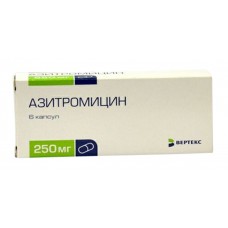Expiration date: 11/2026
Chemical name: 9-Deoxo-9a-Aza-9a-homoerythromycin a (in the form of dihydrate)
Dosage form: capsules.
Composition
One capsule contains the active substance azithromycin dihydrate (in terms of azithro-micin) – 125, 250 or 500 mg,
auxiliary substances: microcrystalline cellulose-40, 6 mg, povidone low-molecular (polyvinylpyrrolidone low-molecular) - 1, 0 mg, magnesium stearate-3, 7 mg, na-triya lauryl sulfate-0, 7 mg, lactose monohydrate-to obtain the contents of the capsule weighing 370 mg,
hard gelatin capsules: titanium dioxide ENU 2%, gelatin ENU up to 100%.
Description
Hard gelatin capsules white color. The contents of capsules-white or white powder with a light yellow hue. Conglomerates are allowed, which, when pressed with a glass rod, can be easily converted into loose powder.
Pharmacotherapeutic group: Antibiotic-azalide.
ATC code: J01FA10.
Pharmacological properties
Pharmacodynamics
The broad-spectrum antibiotic. It is a representative of a subgroup of macrolide antibiotics-azalides, acts bacteriostatically. When creating inflammation in the focus of high concentrations, it has a bactericidal effect.
It acts on extracellular and intracellular pathogens. To azithromycin sensitive gram-positive microorganisms: Streptococcus pneumoniae, Streptococcus pyogenes, Streptococcus agalaciae, streptococci groups C, F and G, Staphylococcus aureus, Streptococcus viridans, gram-negative microorganisms: Haemophilus influenzae, Moraxella catarrhalis, Bordetella pertussis, Bordetella parapertussis, Legionella pneumophila, Haemophilus ducrei, Campylobacter jejuni, Neisse-ria gonorrhoeae and Gardnerella vaginalis, selected anaerobic microorganisms: Bacteroides bivius, Clostridium perfringens, Peptostreptocoiccus spp, and Chlamydia trachomatis, My-coplasma pneumoniae, Ureaplasma urealyticum, Treponema pallidum, Borrelia burgdorferi. Azithromycin is inactive against gram-positive bacteria resistant to erythromycin.
Pharmacokinetics
Azithromycin is rapidly absorbed from the gastrointestinal tract due to its abutment-very robust over in an acidic environment and lipophilicity. After intake of 500 mg, the maximum the concentration of azithromycin in plasma achieved through 2, 5 – 2, 9 and h is 0, 4 mg/l. Bioavailability is 37 %. Azithromycin penetrates well into the respiratory tract, organs and tissues of the urogenital tract (in particular the prostate gland), into the skin and soft tissues. High concentration in tissues (10-50 times higher than in blood plasma) and long half-life due to low binding of azithromycin to plasma proteins of blood, as well as its ability to penetrate into eukaryotic cells and concentrate in an environment with low pH, environmental lysosomes. This, in turn, determines the large apparent volume of distribution (31, 1 l/kg) and the high plasma clearance. The ability of azithromycin to drip mainly in lysosomes is especially important for the elimination of intracellular pathogens. It is proved that phagocytes deliver azithromycin to places of infection localization, where it is released in the process of phagocytosis. The concentration of azithromycin in the foci of injection is significantly higher than in healthy tissues (on average 24-34 %) and correlates with the degree of inflammatory edema. Despite the high concentration in phagocytes, azithromycin has no significant effect on their function. Azithromycin remains in bactericidal concentrations for 5-7 days after taking the last dose, which allowed to develop short (3-day and 5-day) courses of treatment.
Demetiliruetsa in the liver, the resulting metabolites are not active.
The removal of azithromycin from blood plasma takes place in 2 stages: the half-life of 14-20 hours in the range of 8 to 24 hours after taking the drug and 41 hours – in the range of 24 to 72 hours, which allows the drug to be used 1 time per day.
50% is excreted with bile in unchanged form, 6 % – the kidneys.
Indications for use
Infectious and inflammatory diseases caused by micro-organisms sensitive to the drug:
- infections of the upper respiratory tract and ENT organs (angina, sinusitis, tonsillitis, pharyngitis, otitis media),
- scarlatina,
- lower respiratory tract infections (including those caused by atypical agents),
- infections of the skin and soft tissues (erysipelas, impetigo, secondary infected dermatoses),
- urogenital tract infections (uncomplicated urethritis and/or cervicitis),
- Lyme disease (borreliosis), for the treatment of the initial stage (erythema migrans),
- diseases of the stomach and duodenum associated with Heliobacter pylori (as part of combination therapy).
Contraindications
Hypersensitivity (including to other macrolides), hepatic and/or renal insufficiency, lactation period, children's age up to 12 years.
Caution-during pregnancy, arrhythmia, children with impaired liver and/or kidney function.
Use in pregnancy and lactation
It can be used during pregnancy, when the benefits of its application significantly increases the risk that exists always when using any drug during pregnancy.
If necessary, the appointment of the drug during lactation, it is necessary to resolve the issue of termination of breastfeeding.
Method of application and doses
Inside, 1 hour before or 2 hours after meals 1 time per day.
Adults with infections of the upper and lower respiratory tract – 500 mg/day for 1 meal for 3 days (course dose-1, 5 g).
With infections of the skin and soft tissues – 1000 mg/day on the first day for 1 reception, then 500 mg/day daily from 2 to 5 day (course dose – 3 g).
In acute infections of the genitourinary organs (uncomplicated urethritis or cervicitis) - one-fold 1000 mg.
In Lyme disease (borreliosis) for the treatment of stage I (erythema migrans) – 1000 mg on the first day and 500 mg daily from 2 to 5 day (course dose – 3 g).
When ulcers stomach and duodenal ulcers associated with Helicobacter pylori – 1 g/day for 3 days in combination therapy of H. pylori.
Children over 12 years (body weight 50 kg and more) with infections of the upper and lower respiratory system-tion, skin and soft tissues - 500 mg 1 time per day for 3 days.
When treating erythema migrans in children dose-1000 mg on the first day and 500 mg daily from 2 to 5 day.
Side effect
The gastro-intestinal tract: diarrhea (5 %), nausea (3 %), abdominal pain (3 %), 1 % or less – dyspepsia (bloating, vomiting), melena, cholestatic jaundice, increased activity of "liver" transaminases in children – constipation, anorexia, gastritis, change of taste, candidiasis mucous membranes of the oral cavity (1 % or less).
From the side of cardiovascular system: palpitations, chest pain (1 % and less her).
From the nervous system: dizziness, headache, drowsiness, in children – headache (in the treatment of otitis media), hyperkinesia, anxiety, neurosis, sleep disorders (1% or less).
From the genitourinary system: vaginal candidiasis, nephritis (1% or less).
Allergic reactions: rash, swelling of quince, itching of the skin, urticaria, in children – conjunctivitis, itching, urticaria.
Other: fatigue, photosensitization.
Overdose
Symptoms: severe nausea, temporary hearing loss, vomiting, diarrhea.
Treatment: immediate gastric lavage and symptomatic treatment.
Interaction with other drugs
Antacids (aluminum and magnesium containing), ethanol and food slow down and reduce absorption.
The joint appointment of warfarin and azithromycin (in normal doses) changes in Pro-thrombin time was not revealed, however, given that the interaction of macrolides and warfarin may increase anticoagulation effect, patients need careful quantity control of prothrombin time.
Digoxin: increasing the concentration of digoxin.
Ergotamine and dihydroergotamine: increased toxic effect (vasospasm, dysesthesia).
Triazolam: decrease in clearance and increase the pharmacological action of triazolam.
Slows excretion and increases the plasma concentration and toxicity of cycloserine, indirect anticoagulants, methylprednisolone, felodipine, and drugs, under-virgaudas microsomal oxidation (carbamazepine, terfenadine, cyclosporine, hexa-Barbital, ergot alkaloids, valproic acid, disopyramide, bromocriptine, phenytoin, oral gipoglikemicakie means, theophylline and other xantinove derivatives) – due to inhibition of microsomal oxidation in hepatocytes by azithromycin.
Lincosamine weaken the effectiveness of tetracycline and chloramphenicol – strengthen.
Special instruction
In the case of missing dose missed dose should be taken as early as possible, and the following-at intervals of 24 hours.
It is necessary to observe a break of 2 hours with the simultaneous use of antacids.
After discontinuation of treatment of reaction of hypersensitivity at some patients can maintain change, which requires specific therapy under medical supervision.
Form release
Capsules of 125, 250 or 500 mg. of 3 or 6 capsules in a contour cell package. On 6 capsules in banks polymeric. Each contour packing or Bank together with the instruction on application place in a pack from a cardboard.
Storage conditions
In a dark place at a temperature not exceeding 25 ° C.
Keep out of reach of children.
Shelf life
3.5 years. Do not use after expiry date.




